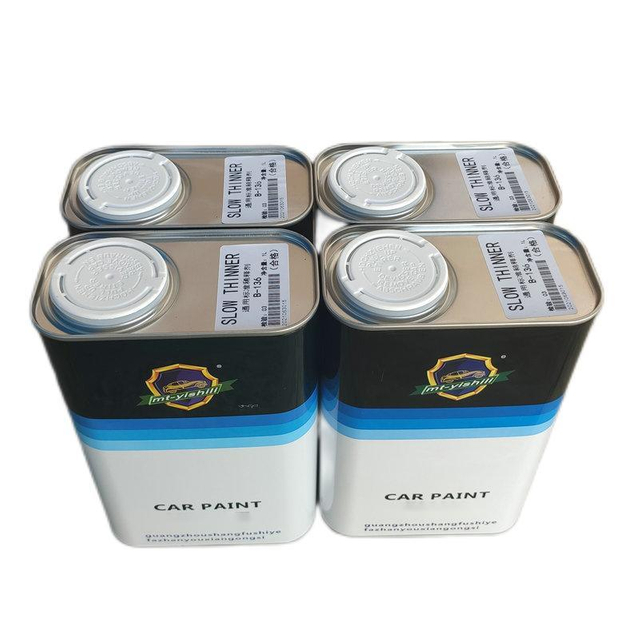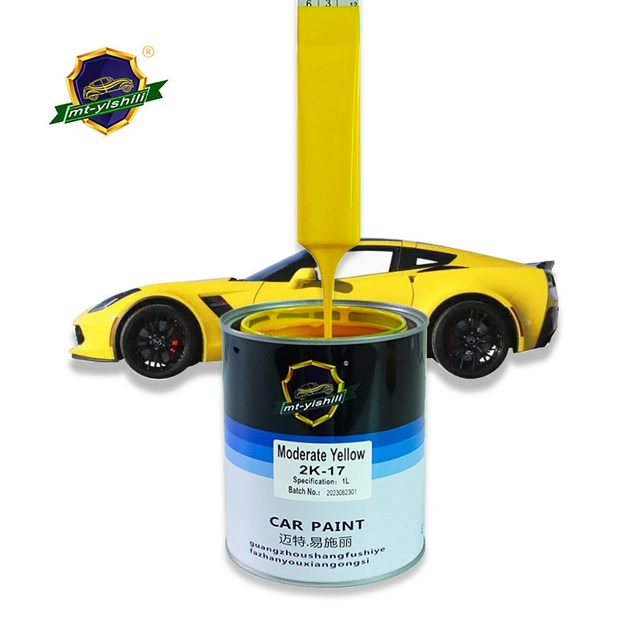
When it comes to car paint, it’s not just about the color – it’s about the technology and formulation behind it. Unlike regular paint, automotive paint is specifically engineered to withstand the challenges of outdoor environments and the wear and tear of everyday driving. Whether you're looking for a long-lasting finish, protection from UV rays, or resistance to road debris, understanding what makes automotive paint unique is essential to making the right choice for your car.
In this comprehensive guide, we’ll explore the different types of automotive paints, their durability, and the factors that make them different from regular household paint. If you’ve ever wondered about the differences between 1K vs. 2K paints, the best car color paints, or why pearl paints are so special, this guide will give you all the insights you need.
What Sets Automotive Paint Apart from Regular Paint?
Automotive paint is specifically designed to address the unique challenges of outdoor exposure and provide a durable, long-lasting finish for vehicles. Unlike regular paint used indoors, automotive paint must be resistant to UV rays, environmental conditions, road debris, and frequent cleaning. Let’s break down the factors that make automotive paint different from regular paint:
1. Durability and Resistance
Automotive paints are designed to be much more durable than the paints used for interior or exterior household projects. They are formulated to handle the following:
UV Protection: UV rays from the sun can cause regular paint to fade over time. Automotive paints have built-in UV protectants that help prevent fading and oxidation, keeping your car looking newer for longer.
Weather Resistance: Whether it's extreme temperatures, heavy rain, or snow, automotive paints are designed to withstand the elements and protect the vehicle’s surface from damage.
Chemical Resistance: Cars are exposed to harsh chemicals such as gasoline, oil, and cleaning solutions. Automotive paints are formulated to be resistant to these chemicals, preventing damage and degradation.
Scratch and Chip Resistance: Automotive paints are more resistant to scratches and chips caused by road debris, making them ideal for vehicles that travel long distances or through harsh conditions.
2. Multi-layer System
The typical automotive paint system involves multiple layers, each serving a different function:
Primer: This is the first layer applied to the metal surface. It ensures that the paint adheres properly and provides a barrier to prevent rust and corrosion.
Base Coat: The base coat provides the actual color of the vehicle. Depending on the finish (matte, gloss, or metallic), the base coat is designed for smoothness and vibrancy.
Clear Coat: The final layer of automotive paint is the clear coat, which adds gloss, shine, and an additional layer of protection from the elements, UV rays, and minor scratches.
This multi-layer system ensures that automotive paint provides durability and high aesthetic appeal.
Types of Automotive Paint
There are several types of automotive paints, each with distinct characteristics, uses, and benefits. Let’s take a closer look at some of the most common types of automotive paints:
1. 1K Automotive Paint
1K automotive paint is a single-component paint that doesn’t require mixing with a hardener or activator. It's easy to apply and is often used for small touch-ups or DIY jobs.
Durability: Moderate, not as durable as 2K paints
Best for: Quick touch-ups or small repairs
Application: No mixing required, making it suitable for beginners
Drying Time: Fast, usually 1-3 hours
While 1K paint is convenient and cost-effective for small repairs, it doesn’t provide the same level of protection and durability as more advanced paint types.
2. 2K Automotive Paint
2K automotive paint is a two-component system, meaning it needs to be mixed with a hardener or activator before use. This type of paint is highly durable and provides a professional-grade finish.
Durability: High, suitable for long-lasting protection
Best for: Professional jobs and high-durability applications
Application: Requires mixing, which can make it more complex to use
Drying Time: 2-4 hours for touch-drying, full curing may take up to 72 hours
2K paint offers superior scratch resistance, UV protection, and overall durability, making it ideal for vehicles that need long-lasting protection. It is also the preferred choice for professional painters and for applications that require heavy-duty protection.
3. Metallic Paints
Metallic automotive paint is known for its reflective properties, giving the car a shiny, sparkly finish. These paints are typically used in high-end cars and custom vehicles.
Durability: High, but needs regular maintenance
Best for: Luxury and custom cars
Drying Time: Similar to 2K paints, around 3-5 hours for touch-drying
While metallic paints are stunning and popular for luxury vehicles, they can be challenging to maintain. The reflective particles in metallic paint can degrade over time without the proper care. Applying a clear coat over metallic paints helps protect the finish.
4. Pearl Paints
Pearl paints offer a shimmering, iridescent effect that changes based on the angle of light. These paints are often used for unique finishes and high-end custom cars.
Durability: High, but requires regular maintenance
Best for: Show cars, custom vehicles, and high-end applications
Drying Time: 3-5 hours for touch-drying, full curing takes up to 72 hours
Like metallic paints, pearl finishes need a clear coat for optimal protection. Regular waxing and maintenance are essential to keep the finish vibrant and resistant to fading.

Choosing the Best Automotive Paint for Your Vehicle
Selecting the best automotive paint depends on several factors, including the type of vehicle, the desired finish, and the climate it will be exposed to. Here are some key factors to consider when choosing the right paint:
1. Vehicle Type and Usage
The best paint for a luxury car will likely be different from what’s ideal for a daily commuter. For luxury cars or custom vehicles, you may want a metallic or pearl finish to achieve a sleek, sophisticated look. For everyday cars, 2K paints provide excellent durability and protection against the elements, making them ideal for long-term use.
2. Evaluate Your Environment
If you live in an area with extreme weather conditions, such as high UV exposure, snow, or intense heat, you’ll need a paint type that can withstand these conditions. 2K automotive paints are highly resistant to UV rays, rain, snow, and dirt, making them perfect for areas with harsh climates.
3. Determine Your Budget
Metallic and pearl finishes typically cost more due to their complexity, while 1K paints are more budget-friendly. Consider how much you are willing to spend, especially if the car will be exposed to harsh conditions or will need frequent touch-ups.
How to Maintain the Longevity of Automotive Paint
Proper maintenance is crucial for ensuring that your automotive paint stays vibrant and durable for years. Follow these tips to protect your paint job and keep your vehicle looking its best:
1. Regular Washing
Regularly wash your car to remove dirt, grime, and other contaminants that can degrade the paint over time. Use a mild soap designed specifically for automotive paint to avoid damage.
2. Waxing
Applying wax every few months adds an extra layer of protection against UV rays and other environmental factors. Car wax helps maintain the gloss and shine of your paint, especially for metallic or pearl finishes.
3. Clear Coat Application
Applying a clear coat on top of your paint job is one of the best ways to protect it from fading and scratching. If your vehicle has metallic or pearl paint, this layer is even more important for maintaining its unique shine and durability.
4. Parking in a Garage
Whenever possible, park your vehicle in a garage or under a carport to protect it from prolonged sun exposure, which can lead to fading and oxidation. UV rays are one of the main causes of paint deterioration.
FAQs
Q1: What is different about automotive paint?
A1: Automotive paint is specially formulated to withstand UV rays, extreme weather conditions, and road debris, making it far more durable than regular paint.
Q2: Which automotive paint lasts the longest?
A2: 2K automotive paint offers the longest-lasting protection due to its high durability, scratch resistance, and UV protection.
Q3: Can I paint my car myself?
A3: Yes, you can use 1K automotive paint for DIY jobs, but for a professional finish, it’s recommended to use 2K automotive paint and apply multiple coats with proper equipment.
Q4: How do I maintain my car’s paint?
A4: Regular washing, waxing, and applying a clear coat can help maintain the paint’s gloss and protect it from the elements.
Q5: What is the difference between metallic and pearl paint?
A5: Metallic paint has small metal flakes that give it a shiny effect, while pearl paint contains special pigments that create a shimmering, color-shifting effect under different lighting.
Q6: How long does automotive paint last?
A6: The lifespan of automotive paint depends on the type and maintenance. 2K automotive paint can last up to 10 years with proper care, while 1K paint may need more frequent touch-ups.
Q7: How do I protect my car paint from UV rays?
A7: Apply car wax regularly and use a clear coat to provide UV protection. Parking in the shade and using a car cover can also help protect the paint from sun damage.
Understanding what makes automotive paint different from regular paint is essential for selecting the best product for your vehicle. Whether you're opting for black automotive paint, red automotive paint colors, or a more specialized car color paint, knowing the type of paint and its properties will help you make an informed decision.
By choosing the right automotive paint—whether it’s 2K, metallic, or pearl paints—and following proper maintenance tips, you can ensure that your car stays protected, vibrant, and looking great for years to come. If you're ready to get started on your car paint project, consult a professional or visit an automotive paint supplier for expert advice and the right products for your needs.
Interested in transforming your vehicle with the best automotive paint? Contact us today for a free consultation and get a personalized quote for your paint job. Whether you need a custom car color paint or a durable 2K finish, we’ve got you covered!




















